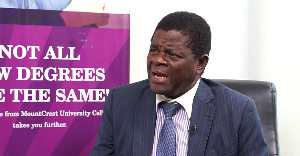One million, four hundred and thirteen thousand, three hundred and thirty three (1,413,333) hectares of cocoa farms in the country have benefited from the free fertilizers under Ghana Cocoa Board’s (COCOBOD) fertilizer and chemical programs in the 2015/2016 cocoa season, myradio360.com can report.
According to a statistics by the Cocoa regulator, available to this website, farmers received 2, 500, 000 bags of Granular fertilizer, 1, 600, 000 liters of Foliar, 200, 000 bags of Ammonia and 400, 000 liters of Extra fertilizers to aid in boosting production for the season.
This feat is an improvement in the quantities, timing and other operational arrangements which existed previously under the program.
Until 2014, cocoa fertilizers were sold to farmers at a subsidized rate of 40/60 percentage.This translate to mean that government absorbed 60 percent while farmers paid 40 percent.
However, the small-holder cocoa farmers were still finding it difficult to buy them for their farms, resulting in the replacement of the old system with free distribution of fertilizers to farmers to enhance farmers’ access to the fertilizers.
The fact sheets indicated that the free Mass Spraying and fertilizer distribution, CODAPEC and HITECH which were introduced in 2001, have been enhanced with the increase in the quantity of fertilizers and inputs supplied to farmers.
“The inputs are supplied directly to cocoa farmers. To ensure transparency in the distribution exercise, COCOBOD inaugurated new taskforces in all the cocoa districts in the country”, it said.
Aside the free distribution of fertilizer, COCOBOD has added a number of interventions to boost cocoa production.
The interventions include: Youth in Cocoa Initiative, which provides an attractive support package to woo the youth into Cocoa farming with business motive.
Others include: motivating cocoa communities through programmes such as the Cocoa Roads Programme which aims at opening up the remote cocoa areas to aid the carting of cocoa beans to buying centres, Child Education Support Programme, another on-going concrete step by the Board to provide educational support in deprived cocoa communities to enhance basic education while at the same time, addressing Worst Forms of Child Labour (WFCL) in cocoa production.
Under the new intervention, there is also an increased annual COCOBOD Scholarship Awards to assist more wards of farmers who have gained admission to 2nd Cycle Institutions in the country.
Cocoa Production History
According to the fact sheet, the annual cocoa production in 2000/2001 crop season stood at 380,772 tonnes.
It said the introduction of the Mass Spraying and Hi-Tech Programmes in 2001 and 2002 led to significant increase in production to 740,452 tonnes in the 2005/06 Crop Season respectively.
The average production from 2001/2002 to 2007/2008 stood at 574,896.75 tonnes, it added.
This feat was arrived at due to the organized pests and diseases control regime as well as the Hi-Tech programme introduced in the early 2000s.
It was during that period, that fertilizers were subsidized by 60 percentage but very few farmers could not afford it.
From a production level of 710,638 tonnes in the 2008/2009 crop season, Ghana attained its all-time highest production of 1,024,553.31 tonnes in the 2010/11 crop season ahead of it set target to achieve that in 2012.
The 2nd highest production of 896,221 tonnes was recorded in the 2013/14 crop season.
The average production spanning the period 2008/9 and 2014/15 crop seasons is 816,931.12 tonnes.
Problem Sets In
It was established by COCOBOD that 23 percent of cocoa tree stock was over-aged and 17 percent infested with the Cocoa Swollen Shoot Virus Disease (CSSVD) leading to low yield.
To address this problem, the National Cocoa Rehabilitation Programme was re-introduced in 2011 with the view to replanting old and diseased tree stock with improved hybrid seedlings.
There has since been progressive increase in the supply of early bearing, high yielding hybrid and disease tolerant cocoa seedlings free of charge to farmers annually.
In the 2014/15 Crop Season, 50 million Seedlings were supplied to cover approximately 40,000 hectares of cocoa farms.
“60 million hybrid seedlings were raised in 2015/16 and distributed to farmers across the cocoa regions to cover about 50,000 hectares land size. To produce 60 million seedlings, 4800 young persons have been employed. Some of them have taken advantage of this to establish their own farms. Boreholes are being provided around all the 331 nursery sites across the growing regions”, the statistics disclosed.
In the next ten years, this will create approximately 500,000 hectares of cocoa farms, it indicated.
With adherence to good agronomic practices, each hectare will bring in 1.5 tonnes of cocoa, hence in the next ten years, additional 750,000 mt of cocoa will be produced.
Producer Price
Cocoa Producer Price has seen significant increase over the years to motivate farmers to continue to invest in cocoa, the fact sheet noted.
By Government of Ghana’s policy, at least 70 percent of the net Free on Board (FOB) is paid to farmers as producer price.
In the 2013/14 crop year, even in the face falling world market price of cocoa, Government maintained the producer price at GHC 3,392 per ton.
In the 2014/15 season, farmers were paid GHC 5,520.00 with an additional GHc80) per ton.
Again, in the 2015/16 crop year, cocoa farmers were paid GHC 6,720 and additional GHC 80.
Business News of Friday, 30 September 2016
Source: myradio360.com

















